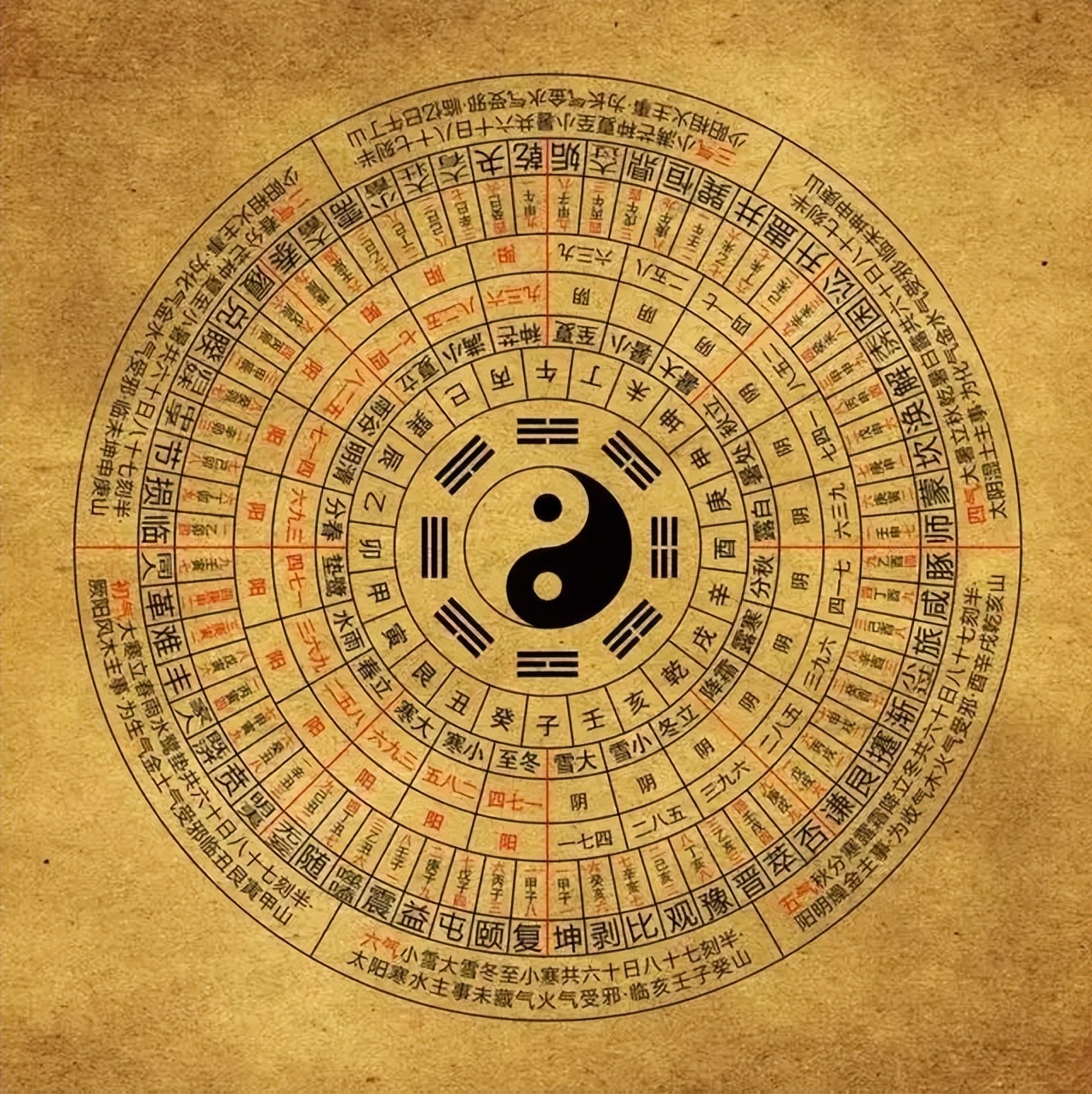| 坤(地) | 艮(山) | 坎(水) | 巽(風) | 震(雷) | 離(火) | 兌(泽) | 乾(天) | ← 上卦 ↓ 下卦 |
| 2. 坤為地 | 23. 山地剥 | 8. 水地比 | 20. 風地觀 | 16. 雷地豫 | 35. 火地晋 | 45. 泽地萃 | 12. 天地否 | 坤(地) |
| 15. 地山謙 | 52. 艮為山 | 39. 水山蹇 | 53. 風山漸 | 62. 雷山小過 | 56. 火山旅 | 31. 泽山咸 | 33. 天山遯 | 艮(山) |
| 7. 地水師 | 4. 山水蒙 | 29. 坎為水 | 59. 風水渙 | 40. 雷水解 | 64. 火水未濟 | 47. 泽水困 | 6. 天水訟 | 坎(水) |
| 46. 地風升 | 18. 山風蠱 | 48. 水風井 | 57. 巽為風 | 32. 雷風恒 | 50. 火風鼎 | 28. 泽風大過 | 44. 天風姤 | 巽(風) |
| 24. 地雷復 | 27. 山雷頤 | 3. 水雷屯 | 42. 風雷益 | 51. 震為雷 | 21. 火雷噬嗑 | 17. 泽雷随 | 25. 天雷无妄 | 震(雷) |
| 36. 地火明夷 | 22. 山火賁 | 63. 水火既濟 | 37. 風火家人 | 55. 雷火丰 | 30. 離為火 | 49. 泽火革 | 13. 天火同人 | 離(火) |
| 19. 地泽臨 | 41. 山泽損 | 60. 水泽節 | 61. 風泽中孚 | 54. 雷泽歸妹 | 38. 火泽睽 | 58. 兌為泽 | 10. 天泽履 | 兌(泽) |
| 11. 地天泰 | 26. 山天大畜 | 5. 水天需 | 9. 風天小畜 | 34. 雷天大壮 | 14. 火天大有 | 43. 泽天夬 | 1. 乾為天 | 乾(天) |

《易经》是中国汉族最古老的文献之一[1],并被儒家尊为“五经”之始;一般说上古三大奇书包括《黄帝内经》、《易经》、《山海经》,但它们成书都较晚。《易经》以一套符号系统来描述状态的简易、变易、不易,表现了中国古典文化的哲学和宇宙观。它的中心思想,是以阴阳的交替变化描述世间万物。《易经》最初用于占卜和预报天气,但它的影响遍及中国的哲学、宗教、医学、天文、算术、文学、音乐、艺术、军事和武术等各方面,是一部无所不包的巨著。自从17世纪开始,《易经》也被介绍到西方。在四库全书中为经部,十三经中未经秦始皇焚书之害,它是最早哲学书。自从十七世纪开始,《易经》也被介绍到西方。
《易》原有三种版本:《连山》、《归藏》和《周易》[2],《连山》和《归藏》已经失传,一般所称《易经》即源于《周易》发展而来。
《易经》包括狭义的《周易》与《易传》。《周易》相传是依循周文王主编《易》的著述而来,成书大约在西周时期。由于随时代演变,《周易》文字含义到了春秋战国时代已经不便读懂,因此孔子撰写了“十翼”,后世又称为《易传》并列入《易经》。
Das I Ging, hist. Romanisierung, heute: Yijing (chinesisch 易經 / 易经, Pinyin Yìjīng, W.-G. I-Ching ‚Buch der Wandlungen od. Klassiker der Wandlungen‘) ist eine Sammlung von Strichzeichen und zugeordneten Sprüchen. Es ist der älteste der klassischen chinesischen Texte. Seine legendäre Entstehungsgeschichte wird traditionell bis in das 3. Jahrtausend v. Chr. zurückgeführt. Das Werk ist im Chinesischen allgemein auch als Zhouyi (周易, Zhōuyì ‚Wandlungen der Zhou‘) bekannt.
『易経』(えききょう、正字体:易經、拼音: )は、古代中国の書物。『卜』が動物である亀の甲羅や牛や鹿の肩甲骨に入ったヒビの形から占うものであるのに対して、『筮』は植物である『蓍[1]』の茎の本数を用いた占いである。商の時代から蓄積された卜辞を集大成したものとして易経は成立した。易経は儒家である荀子の学派によって儒家の経典として取り込まれた。現代では、哲学書としての易経と占術のテキストとしての易経が、一部重なりながらも別のものとなっている。中心思想は、陰陽二つの元素の対立と統合により、森羅万象の変化法則を説く。著者は伏羲とされている[2]。
中国では『黄帝内經』・『山海經』と合わせて「上古三大奇書」とも呼ぶ。
The I Ching (/ˈiː ˈdʒɪŋ/),[2] also known as Classic of Changes or Book of Changes, is an ancient Chinese divination text and the oldest of the Chinese classics. Possessing a history of more than two and a half millennia of commentary and interpretation, the I Ching is an influential text read throughout the world, providing inspiration to the worlds of religion, psychoanalysis, literature, and art. Originally a divination manual in the Western Zhou period (1000–750 BC), over the course of the Warring States period and early imperial period (500–200 BC) it was transformed into a cosmological text with a series of philosophical commentaries known as the "Ten Wings".[3] After becoming part of the Five Classics in the 2nd century BC, the I Ching was the subject of scholarly commentary and the basis for divination practice for centuries across the Far East, and eventually took on an influential role in Western understanding of Eastern thought.
The I Ching uses a type of divination called cleromancy, which produces apparently random numbers. Six numbers between 6 and 9 are turned into a hexagram, which can then be looked up in the I Ching book, arranged in an order known as the King Wen sequence. The interpretation of the readings found in the I Ching is a matter of centuries of debate, and many commentators have used the book symbolically, often to provide guidance for moral decision making as informed by Taoism and Confucianism. The hexagrams themselves have often acquired cosmological significance and paralleled with many other traditional names for the processes of change such as yin and yang and Wu Xing.
Le Yi Jing (sinogrammes 易经simpl./易經trad., pinyin yì jīng, Wade-Giles i4 ching1, également orthographié Yi King ou Yi-King), prononcé en français i ting est un manuel chinois dont le titre peut se traduire par « Classique des changements » ou « Traité canonique des mutations ». Il s'agit d'un système de signes binaires qui peut être utilisé pour faire des divinations. Le Yi Jing s'appelle aussi Zhou Yi (周易, pinyin : Zhōu Yì, Wade-Giles : Chou1 I4) c'est-à-dire « changements de Zhou » pour la raison que son élaboration date du Ier millénaire avant l'ère chrétienne, époque des Zhou (1027, 256 av. J.-C.).
Il occupe une place fondamentale dans l'histoire de la pensée chinoise et peut être considéré comme un traité unique en son genre dont la finalité est de décrire les états du monde et leurs évolutions. Premier des cinq classiques, il est donc considéré comme le plus ancien texte chinois.
Le Yi Jing est le fruit d'une recherche spéculative et cosmogonique élaborée, dont les articulations ont influencé durablement la pensée chinoise. Sa structure mathématique a impressionné Leibniz qui y aurait vu la première formulation de l'arithmétique binaire. De fait, partant d'une opposition/complémentarité entre les principes d'engendrement Yin et Yang (yin // réceptif // lune // femelle // passif alors que yang // créatif // soleil // mâle // actif) et subdivisant cette dualité de façon systématique (adret = côté au Soleil alors qu'ubac = côté à l'ombre ; vents favorables opposés aux nuages contraires), le Yi Jing arrive à la série des 64 figures qui peuvent interpréter toutes les transformations possibles.
« Le Yi-King ou Livre des transformations de l'archaïque magie chinoise apporte l'image la plus exemplaire de l'identité du Génésique et du Génétique. La boucle circulaire est un cercle cosmogonique symboliquement tourbillonnaire par le S intérieur qui à la fois sépare et unit le Yin et le Yang. La figure se forme non à partir du centre mais de la périphérie et naît de la rencontre de mouvements de directions opposés. Le Yin et le Yang sont intimement épousés l'un dans l'autre, mais distincts, ils sont à la fois complémentaires, concurrents, antagonistes. La figure primordiale du Yi-King est donc une figure d'ordre, d'harmonie, mais portant en elle l'idée tourbillonnaire et le principe d'antagonisme. C'est une figure de complexité. »
— Edgar Morin, La Méthode 1. La Nature de la Nature, p. 228, Seuil, Paris, 1977.
Il Libro dei Mutamenti[2] (易經T, 易经S, YìjīngP, I ChingW[3]), conosciuto anche come Zhou Yi 周易 o I Mutamenti (della dinastia) Zhou, è ritenuto il primo dei testi classici cinesi sin da prima della nascita dell'impero cinese. È sopravvissuto alla distruzione delle biblioteche operata dal Primo imperatore, Qin Shi Huang Di.
L'Yi Jing è diviso in due porzioni, jing 經 o 'classico' e zhuan 傳 o 'commentario', composti in momenti differenti ma tramandati come testo unico da due millenni circa. La porzione jing è composta da sessantaquattro unità, ognuna basata su un esagramma (gua 卦) composto di sei linee che sono o continue (⚊) rappresentanti il principio yang o interrotte (⚋) rappresentanti il principio yin. Per ogni esagramma vi è una spiegazione chiamata 卦辞 guaci, accompagnata dalla spiegazione delle singole linee costituenti il trigramma chiamate 爻辞 yaoci. I primi due esagrammi del testo 乾 qian e 坤 kun sono accompagnati da due ulteriori testi chiamati 用六 yongliu e 用九 yongjiu.
Considerato da Confucio libro di saggezza, è utilizzato a livello popolare a scopo divinatorio, e dagli studiosi per approfondire aspetti matematici, filosofici e fisici. I metodi per ottenere i responsi sono vari e si passa dai gusci di tartaruga al lancio di 3 monete. Quando si utilizzano gli steli di achillea per estrarre i responsi, l'arte divinatoria è chiamata achilleomanzia.
El I Ching, Yijing o I King (en chino tradicional: 易經; en chino simplificado: 易经; en pinyin: yì jīng) es un libro oracular chino cuyos primeros textos se suponen escritos hacia el 1200 a. C. Es uno de los Cinco Clásicos confucianos.
El término i ching significa ‘libro de las mutaciones’. El texto fue aumentado durante la dinastía Zhou y posteriormente por comentaristas de la escuela de Confucio, pero su contenido original es de procedencia taoísta, y no confucianista. Se cree que describe la situación presente de quien lo consulta y predice el modo en que se resolverá en el futuro si se adopta ante ella la posición correcta. Es un libro adivinatorio y también un libro moral, a la vez que por su estructura y simbología es un libro filosófico y cosmogónico.
«И цзин» (кит. трад. 易經, упр. 易经, пиньинь: Yì Jīng), или «Чжоу И»[1] (周易) — наиболее ранний из китайских философских текстов. Наиболее ранний слой, традиционно датируемый ок. 700 г. до. н. э.[2] и предназначавшийся для гадания, состоит из 64 гексаграмм. Во II веке до н. э. был принят конфуцианской традицией как один из канонов конфуцианского Пятикнижия.
«Кни́га Переме́н» — название, закрепившееся за «И цзин» на Западе. Более правильный, хоть и не столь благозвучный вариант — «Кано́н Переме́н».
| Zeichen | Nr. | Bedeutung n. Wilhelm | 中文 | Pīnyīn |
|---|---|---|---|---|
| 01 | Das Schöpferische | 乾 | qián | |
| 02 | Das Empfangende | 坤 | kūn | |
| 03 | Die Anfangsschwierigkeit | 屯 | chún | |
| 04 | Die Jugendtorheit | 蒙 | méng | |
| 05 | Das Warten | 需 | xū | |
| 06 | Der Streit | 訟 | sòng | |
| 07 | Das Heer | 師 | shī | |
| 08 | Das Zusammenhalten | 比 | bǐ | |
| 09 | Des Kleinen Zähmungskraft | 小畜 | xiǎo chù | |
| 10 | Das Auftreten | 履 | lǔ | |
| 11 | Der Friede | 泰 | taì | |
| 12 | Die Stockung | 否 | pǐ | |
| 13 | Gemeinschaft mit Menschen | 同人 | tóng rén | |
| 14 | Der Besitz von Großem | 大有 | dà yǒu | |
| 15 | Die Bescheidenheit | 謙 | qiān | |
| 16 | Die Begeisterung | 豫 | yù | |
| 17 | Die Nachfolge | 隨 | suí | |
| 18 | Die Arbeit am Verdorbenen | 蠱 | gǔ | |
| 19 | Die Annäherung | 臨 | lín | |
| 20 | Die Betrachtung | 觀 | guān | |
| 21 | Das Durchbeißen | 噬嗑 | shì kè | |
| 22 | Die Anmut | 賁 | bì | |
| 23 | Die Zersplitterung | 剝 | bō | |
| 24 | Die Wendezeit | 復 | fù | |
| 25 | Unschuld | 無妄 | wú wàng | |
| 26 | Des Großen Zähmungskraft | 大畜 | dà chù | |
| 27 | Die Ernährung | 頤 | yí | |
| 28 | Des Großen Übergewicht | 大過 | dà guò | |
| 29 | Das Abgründige | 坎 | kǎn | |
| 30 | Das Feuer | 離 | lí | |
| 31 | Die Einwirkung | 咸 | xián | |
| 32 | Die Dauer | 恆 | héng | |
| 33 | Der Rückzug | 遯 | dùn | |
| 34 | Des Großen Macht | 大壯 | dà zhuàng | |
| 35 | Der Fortschritt | 晉 | jìn | |
| 36 | Die Verfinsterung des Lichts | 明夷 | míng yí | |
| 37 | Die Sippe | 家人 | jiā rén | |
| 38 | Der Gegensatz | 睽 | kúi | |
| 39 | Das Hemmnis | 蹇 | jiǎn | |
| 40 | Die Befreiung | 解 | xìe | |
| 41 | Die Minderung | 損 | sǔn | |
| 42 | Die Mehrung | 益 | yì | |
| 43 | Der Durchbruch | 夬 | guài | |
| 44 | Das Entgegenkommen | 姤 | gòu | |
| 45 | Die Sammlung | 萃 | cùi | |
| 46 | Das Empordringen | 升 | shēng | |
| 47 | Die Bedrängnis | 困 | kùn | |
| 48 | Der Brunnen | 井 | jǐng | |
| 49 | Die Umwälzung | 革 | gé | |
| 50 | Der Tiegel | 鼎 | dǐng | |
| 51 | Das Erregende | 震 | zhèn | |
| 52 | Das Stillehalten | 艮 | gèn | |
| 53 | Die Entwicklung | 漸 | jiàn | |
| 54 | Das heiratende Mädchen | 歸妹 | gūi mèi | |
| 55 | Die Fülle | 豐 | fēng | |
| 56 | Der Wanderer | 旅 | lǚ | |
| 57 | Das Sanfte | 巽 | xùn | |
| 58 | Das Heitere | 兌 | dùi | |
| 59 | Die Auflösung | 渙 | huàn | |
| 60 | Die Beschränkung | 節 | jíe | |
| 61 | Innere Wahrheit | 中孚 | zhōng fú | |
| 62 | Des Kleinen Übergewicht | 小過 | xiǎo gùo | |
| 63 | Nach der Vollendung | 既濟 | jì jì | |
| 64 | Vor der Vollendung | 未濟 | wèi jì |
| 第 1 卦 | 乾為天 | |||
| 卦辭 | 乾:元,亨,利,貞。 | |||
| 象曰 | 天行健,君子以自強不息。 | |||
| 彖曰 | 大哉乾元,萬物資始,乃統天。云行雨施,品物流形。大明始終,六位時成,時乘六龍以御天。乾道變化,各正性命,保合大和,乃利貞。首出庶物,萬國咸寧。 | |||
| 用 九 | 見群龍旡首,吉。 | |||
| 用九,天德不可為首也。 | ||||
| 上 九 | 爻辭:亢龍有悔。 | |||
| 象曰:亢龍有悔,盈不可久也。 | ||||
| 九 五 | 爻辭:飛龍在天,利見大人。 | |||
| 象曰:飛龍在天,大人造也。 | ||||
| 九 四 | 爻辭:或躍在淵,無咎。 | |||
| 象曰:或躍在淵,進無咎也。 | ||||
| 九 三 | 爻辭:君子終日乾乾,夕惕若,厲,無咎。 | |||
| 象曰:終日乾乾,反復道也。 | ||||
| 九 二 | 爻辭:見龍在田,利見大人。 | |||
| 象曰:見龍在田,得施普也。 | ||||
| 初 九 | 爻辭:潛龍勿用。 | |||
| 象曰:潛龍勿用,陽在下也。 | ||||
| | 第 2 卦 | 坤為地 | ||
| 卦辭 | 坤:元,亨,利牝馬之貞。 君子有攸往,先迷后得主,利西南得朋,東北喪朋。安貞,吉。 | |||
| 象曰 | 地勢坤,君子以厚德載物。 | |||
| 彖曰 | 至哉坤元,萬物資生,乃順承天。 坤厚載物,德合無疆。含弘光大,品物咸亨。 牝馬地類,行地無疆,柔順利貞。 君子攸行,先迷失道,后順得常。西南得朋,乃與類行﹔東北喪朋,乃終有慶。安貞之吉,應地無疆。 | |||
| 用 六 | 利永貞。 | |||
| 用六永貞,以大終也。 | ||||
| 上 六 | 爻辭:龍戰於野,其血玄黃。 | |||
| 象曰:龍戰於野,其道窮也。 | ||||
| 六 五 | 爻辭:黃裳,元吉。 | |||
| 象曰:黃裳元吉,文在中也。 | ||||
| 六 四 | 爻辭:括囊﹔無咎,無譽。 | |||
| 象曰:括囊無咎,慎不害也。 | ||||
| 六 三 | 爻辭:含章可貞。 或從王事,無成有終。 | |||
| 象曰:含章可貞﹔以時發也。 或從王事,知光大也。 | ||||
| 六 二 | 爻辭:直,方,大,不習無不利。 | |||
| 象曰:六二之動,直以方也。 不習無不利,地道光也。 | ||||
| 初 六 | 爻辭:履霜,堅冰至。 | |||
| 象曰:履霜堅冰,陰始凝也。 馴致其道,至堅冰也。 | ||||




 Architecture
Architecture
 Astronomy
Astronomy

 IT-Times
IT-Times
 Traditional medicine
Traditional medicine
 Science and technology
Science and technology



